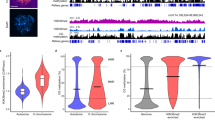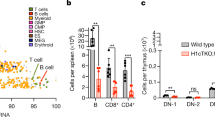Abstract
In female mammals one of the X chromosomes is rendered almost completely transcriptionally inactive1,2 to equalize expression of X-linked genes in males and females. The inactive X chromosome is distinguished from its active counterpart by its condensed appearance in interphase nuclei3, late replication4, altered DNA methylation2, hypoacetylation of histone H4 (ref. 5), and by transcription of a large cis-acting nuclear RNA called Xist6,7,8,9,10. Although it is believed that the inactivation process involves the association of specific protein(s) with the chromatin of the inactive X, no such proteins have been identified11. We discovered a new gene family encoding a core histone which we called macroH2A (mH2A)12,13. The amino-terminal third of mH2A proteins is similar to a full-length histone H2A, but the remaining two-thirds is unrelated to any known histones. Here we show that an mH2A1 subtype is preferentially concentrated in the inactive X chromosome of female mammals. Our results link X inactivation with a major alteration of the nucleosome, the primary structural unit of chromatin.
This is a preview of subscription content, access via your institution
Access options
Subscribe to this journal
Receive 51 print issues and online access
$199.00 per year
only $3.90 per issue
Buy this article
- Purchase on Springer Link
- Instant access to full article PDF
Prices may be subject to local taxes which are calculated during checkout




Similar content being viewed by others
References
Lyon, M. F. Gene action in the X-chromosome of the mouse (Mus musculus L). Nature 190, 372–373 (1961).
Heard, E., Clerc, P. & Avner, P. X-chromosome inactivation in mammals. Annu. Rev. Genet. 31, 571–610 (1997).
Barr, M. L. & Bertram, E. G. Amorphological distinction between neurones of the male and female, and the behaviour of the nucleolar satellite during accelerated nucleoprotein synthesis. Nature 163, 676–677 (1949).
Taylor, J. H. Asynchronous duplication of chromosomes in cultured cells of Chinese hamster. J. Biophys. Biochem. Cytol. 7, 455–464 (1960).
Jeppesen, P. & Turner, B. M. The inactive X chromosome in female mammals is distinguished by a lack of histone H4 acetylation, a cytogenetic marker for gene expression. Cell 74, 281–289 (1993).
Brown, C. J.et al. Agene from the region of the human X inactivation centre is expressed exclusively from the inactive X-chromosome. Nature 349, 38–44 (1991).
Borsani, G.et al. Characterization of a murine gene expressed from the inactive X-chromosome. Nature 351, 325–329 (1991).
Brockdorff, N.et al. Conservation of position and exclusive expression of mouse Xist from the inactive X chromosome. Nature 351, 329–331 (1991).
Brown, C. J.et al. The human XIST gene: analysis of a 17 kb inactive X-specific RNA that contains conserved repeats and is highly localized with the nucleus. Cell 71, 527–542 (1992).
Brockdorff, N.et al. The product of the mouse Xist gene is a 15 kb inactive X-specific transcript containing no conserved ORF and is located in the nucleus. Cell 71, 515–527 (1992).
Willard, H. F. & Salz, H. K. Remodelling chromatin with RNA. Nature 386, 228–229 (1997).
Pehrson, J. R. & Fried, V. A. MacroH2A, a core histone containing a large nonhistone region. Science 257, 1398–1400 (1992).
Pehrson, J. R., Costanzi, C. & Dharia, C. Developmental and tissue expression patterns of histone macroH2A1 subtypes. J. Cell. Biochem. 65, 107–113 (1997).
Monestier, M., Losman, M. J., Novick, K. E. & Aris, J. P. Molecular analysis of mercury-induced antinucleolar antibodies in H-2S mice. J. Immunol. 152, 667–675 (1994).
Breneman, J. W.et al. The development of chromosome-specific composite DNA probes for the mouse and their application to chromosome painting. Chromosoma 102, 591–598 (1993).
Evans, E. P., Burtenshaw, M. D. & Cattanach, B. M. Meiotic crossing-over between the X and Y chromosomes of male mice carrying the sex-reversing (Sxr) factor. Nature 300, 433 (1982).
Hwa, T. C. & Lockhart, L. H. The beginning of the terminal stages of DNA synthesis of human cells with an XXXXY constitution. Hereditas 52, 320–324 (1965).
Migeon, B. R., Wolf, S. F., Axelman, J., Kaslow, D. C. & Schmidt, M. Incomplete X chromosome dosage compensation in chorionic villi of human placenta. Proc. Natl Acad. Sci. USA 82, 3390–3394 (1985).
Kaslow, D. C. & Migeon, B. R. DNA methylation stabilizes X chromosome inactivation in eutherians but not in marsupials: evidence for multistep maintenance of mammalian X dosage compensation. Proc. Natl Acad. Sci. USA 84, 6210–6214 (1987).
Brown, C. J. & Willard, H. F. The human X-inactivation centre is not required for maintenance of X chromosome inactivation. Nature 368, 154–156 (1994).
Penny, G. D., Kay, G. F., Sheardown, S. A., Rastan, S. & Brockdorff, N. Requirement for Xist in X-chromosome inactivation. Nature 379, 131–137 (1996).
Herzing, L. B. K., Romer, J. T., Horn, J. M. & Ashworth, A. Xist has properties of the X-chromosome inactivation centre. Nature 386, 272–275 (1997).
Lee, J. T. & Jaenisch, R. Long-range cis effects of ectopic X-inactivation centres on a mouse autosome. Nature 386, 275–279 (1997).
Marahrens, Y., Panning, B., Dausman, J., Strauss, W. & Jaenisch, R. Xist-deficient mice are defective in dosage compensation but not spermatogenesis. Genes Dev. 11, 156–166 (1997).
Clemson, C. M., McNeil, J. A., Willard, H. F. & Lawrence, J. B. Xist RNA paints the inactive X chromosome at interphase: evidence for a novel RNA involved in nuclear/chromosome structure. J. Cell Biol. 132, 259–275 (1996).
Acknowledgements
We thank E. M. Eicher for the XXsxr mice; M. Monestier for the anti-fibrillarin antibody; M. L. Atchison, E. L. F. Holzbaur, O. Jacenko, L. D. Peachey and J. D. Tucker for making their resources available; G. Gray-Board, E. A. Holleran, X. Lowe, M. Radic and J. D. Tucker for technical advice; and M. L. Atchison, N. G. Avadhani, J. Burch, L. H. Cohen and E. A. Holleran for comments on this manuscript. This work was supported by the NIH. Part of this work was done in the Biomedical Image Analysis Facility at the University of Pennsylvania, supported by the NIH. The dog material was supplied by A. Polesky and J. H. Wolfe, supported by the NIDDK.
Author information
Authors and Affiliations
Corresponding author
Rights and permissions
About this article
Cite this article
Costanzi, C., Pehrson, J. Histone macroH2A1 is concentrated in the inactive X chromosome of female mammals. Nature 393, 599–601 (1998). https://doi.org/10.1038/31275
Received:
Accepted:
Issue Date:
DOI: https://doi.org/10.1038/31275
This article is cited by
-
Deficiency of histone variant macroH2A1.1 is associated with sexually dimorphic obesity in mice
Scientific Reports (2023)
-
Deletion of the XIST promoter from the human inactive X chromosome compromises polycomb heterochromatin maintenance
Chromosoma (2021)
-
Histone H2A variants alpha1-extension helix directs RNF168-mediated ubiquitination
Nature Communications (2020)
-
Characterization of chromatin at structurally abnormal inactive X chromosomes reveals potential evidence of a rare hybrid active and inactive isodicentric X chromosome
Chromosome Research (2020)
-
Histone variant MacroH2A1 is downregulated in prostate cancer and influences malignant cell phenotype
Cancer Cell International (2019)
Comments
By submitting a comment you agree to abide by our Terms and Community Guidelines. If you find something abusive or that does not comply with our terms or guidelines please flag it as inappropriate.



